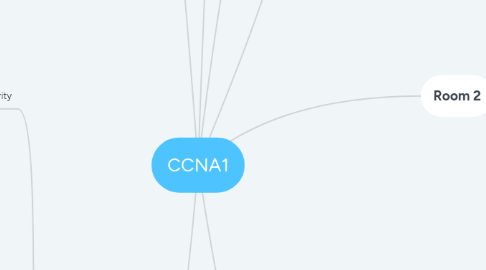
1. Click TAB to pop up a text window
2. Room 5
2.1. Switching
2.1.1. store-and-forward switching
2.1.1.1. stores entire frame
2.1.1.2. Cyclic Redundancy Check
2.1.1.3. checks frame length
2.1.1.4. Intermediate nodes store the data & verify its integrity before forwarding it on.
2.1.2. cut-through switching
2.1.2.1. low latency
2.1.2.2. runt frames
2.1.2.3. Forwarding starts before the whole frame is received.
2.1.3. Switch Virtual Interface (SVI)
2.1.3.1. VLAN Tagging
2.1.4. VTY lines
2.1.4.1. SSH
2.1.4.1.1. Requires default gateway
2.1.4.1.2. Requires local username and password
2.1.5. MAC Address Table
2.1.5.1. The switch forwards frames by searching for a match between the destination MAC address in the frame and an entry in the MAC address table.
2.1.6. Operates at Layer 2 OSI
2.1.7. Auto MDIX
2.2. Routing
2.2.1. Routing Table
2.2.1.1. Static Route
2.2.1.1.1. Gateway of last resort
2.2.1.2. Dynamic
2.2.1.3. Connected
2.2.2. IPv6
2.2.2.1. Router Advertisement
2.2.2.2. Neighbor Discovery
2.2.2.3. Router Solicitation
2.2.2.4. Neighbor Advertisements
2.2.3. VTY lines
2.2.3.1. SSH
2.2.3.1.1. line vty 0 15
2.2.3.1.2. Secure
2.2.3.1.3. Port: 22
2.2.3.2. Telnet
2.2.3.2.1. line vty 0 4
2.2.3.2.2. Insecure
2.2.3.2.3. Port: 23
2.2.4. Operates at Layer 3 OSI
3. Room 4
3.1. Network security
3.1.1. Firewalls
3.1.1.1. Packet filtering
3.1.1.2. Application filtering
3.1.1.3. URL filtering
3.1.1.4. Stateful packet inspection
3.1.1.5. Geo-IP Filtering
3.1.1.6. TLP Protocol
3.1.1.6.1. TLP Green
3.1.1.6.2. TLP Red
3.1.1.6.3. TLP Amber
3.1.1.6.4. TLP White
3.1.2. AAA (Authentication, Authorization and accounting
3.1.3. Threats
3.1.3.1. Physical threats
3.1.3.1.1. Flood
3.1.3.1.2. Fire
3.1.3.1.3. Break and Enter
3.1.3.2. Social engineering
3.1.3.2.1. Phishing
3.1.3.2.2. Impersonation
3.1.3.3. Virus/Worm
3.1.3.4. DOS (Denial of Service)
3.1.4. CIA (Confidentiality, Integrity, Availability)
3.1.5. Device Security
3.1.5.1. Upgrade, update patch
3.1.5.2. Backups & Disaster Recovery
3.1.5.3. Disable Telnet/Enable SSH
3.1.5.4. Strong passwords/encrypt
3.1.6. Network Segmentation
3.1.7. Virtual Private Networks
3.1.8. Intrusion Prevention Systems
3.2. Troubleshooting
3.2.1. Test commands
3.2.1.1. Ping
3.2.1.2. tracert
3.2.1.3. nslookup
3.2.1.4. netstat -r
3.2.1.5. Show interfaces
3.2.1.6. ipconfig /all
3.2.1.7. dig
3.2.2. Steps
3.2.2.1. Identify the problem
3.2.2.2. Establish theory
3.2.2.3. Test theory
3.2.2.4. Plan of action, solution
3.2.2.5. Verify solution, prevention measures
3.2.2.6. Document
3.2.3. debug
3.2.3.1. debug ip icmp
3.2.3.2. Turn off
3.2.3.2.1. no debug ip icmp
3.2.3.2.2. undebug ip icmp
3.2.3.2.3. undebug all
3.2.4. Have you turned it off and on again?
3.2.5. Baseline
3.2.6. Resolve or escalate
3.2.6.1. follow company policy
3.2.7. Possible causes
3.2.7.1. Duplex mismatch
3.2.7.2. Ip addressing issues
3.2.7.3. Default gateway issues
3.2.7.4. DNS issues
3.2.8. Is it plugged in?
4. Room1
4.1. VLSM
4.1.1. Largest to smallest subnet
4.1.2. More efficient than flsm
4.1.3. Unnecessary for IPv6
4.1.4. Smaller subnets are nested within larger ones
4.1.5. Class
4.1.5.1. A
4.1.5.1.1. Default subnet 255.0.0.0
4.1.5.1.2. 0-127 first octet
4.1.5.2. B
4.1.5.2.1. Default subnet 255.255.0.0
4.1.5.2.2. 128-192 first octet
4.1.5.3. C
4.1.5.3.1. Default 255.255.255.0
4.1.5.3.2. 192-223 first octet
4.2. IPv4/IPv6
4.2.1. 32bit vs 128bit addresses
4.2.2. IPv6 supports multicast addressing
4.2.3. Global unicast addresses (2000::/3) and link local addresses (fe80::/10)
4.2.4. IPv4 loopback addresses (127.0.0.0/8), private addresses (10.0.0.0/8, 192.168.0.0/16, 172.16.0.0/12)
4.2.5. IPv6 anycast addresses
5. Room 2
5.1. Ethernet
5.1.1. Layer 1 TCPIP
5.1.1.1. Copper cabling with 564A/564B
5.1.1.1.1. Can use MDIX for autoconfiguration of the ethernet
5.1.1.2. Electrical pulses to send data
5.1.1.3. Carries the bits of the frame to destinations
5.2. ARP
5.2.1. Layer 2 TCP/IP
5.2.1.1. Maps IP to MAC
5.2.1.1.1. Uses broadcast
5.2.1.1.2. FF:FF:FF:FF:FF:FF
5.2.1.1.3. Braodcasted message is not send back on the port which was used to send the bcast message
5.2.2. ARP Issues - ARP Broadcasts and ARP Spoofing
5.2.2.1. Broadcast frames need to be processed by all devices on local network = reduction in performance.
5.3. ARP in IPv4, ND in IPv6
6. Room 3
6.1. ICMP
6.1.1. used for echo reply
6.1.1.1. ICMPv6
6.1.1.1.1. Router Solicitation
6.1.1.1.2. Router Advertisement
6.1.1.1.3. Neighbor Solicitation
6.1.1.1.4. Neighbor Advertisement
6.1.1.2. troubleshooting
6.1.1.3. Destination Unreachable codes for ICMPv4 • 0 - Net unreachable • 1 - Host unreachable • 2 - Protocol unreachable • 3 - Port unreachable
6.1.1.4. Destination Unreachable codes for ICMPv6 are as follows: • 0 - No route to destination • 1 - Communication with the destination is administratively prohibited (e.g., firewall) • 2 – Beyond scope of the source address • 3 - Address unreachable • 4 - Port unreachable
6.1.2. TTL IPV4 determines if time exceeded
6.2. DNS
6.2.1. Domain name service
6.2.1.1. convert name to IP address
6.2.1.1.1. Can be reverse to convert IP to name
6.2.1.1.2. port 53
6.2.1.1.3. UDP, TCP
6.3. DHCP
6.3.1. Dynamically assign IP address
6.3.1.1. Dynamic host configuration protocol
6.3.1.2. port 67 - server
6.3.1.3. port 68 - client
6.3.1.4. UDP
7. Room 6
7.1. Network Layer
7.1.1. TCP/UDP
7.1.2. IP
7.1.3. IPX/SPX
